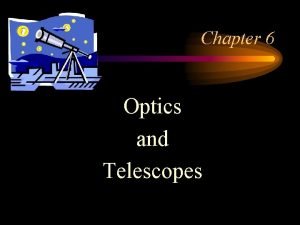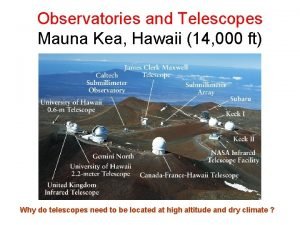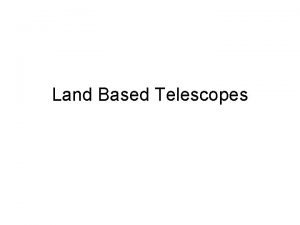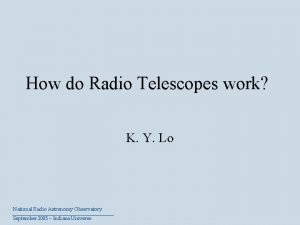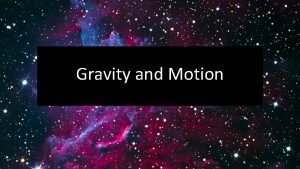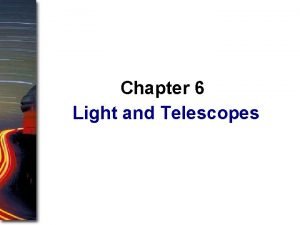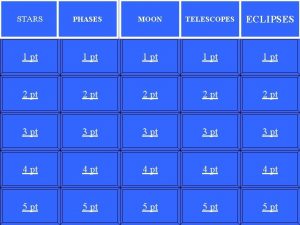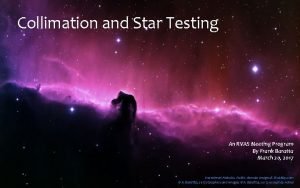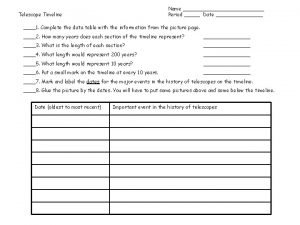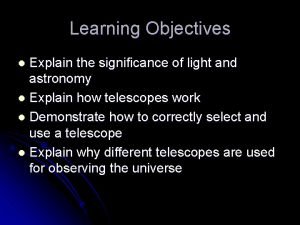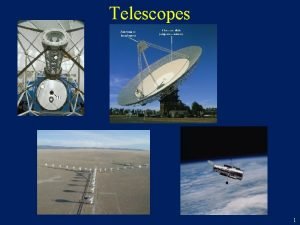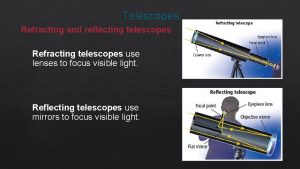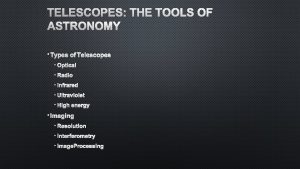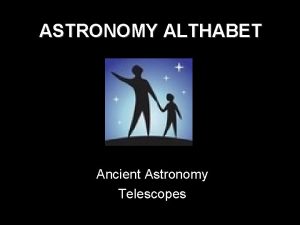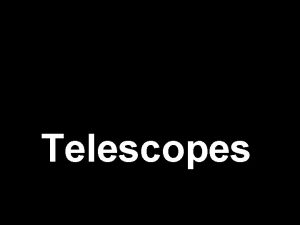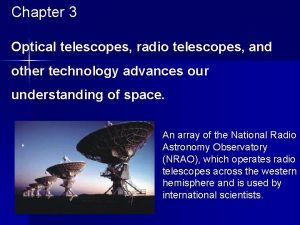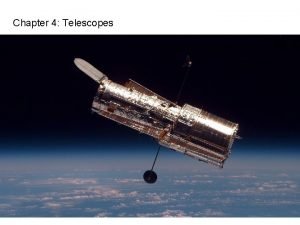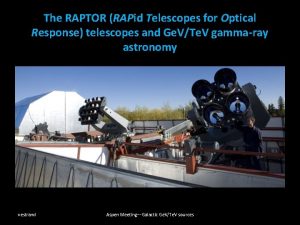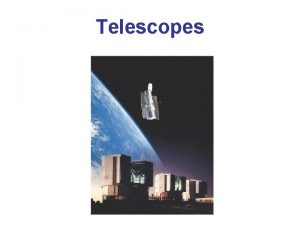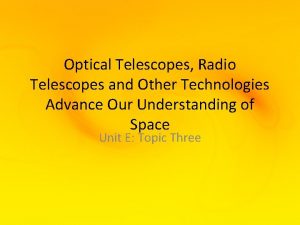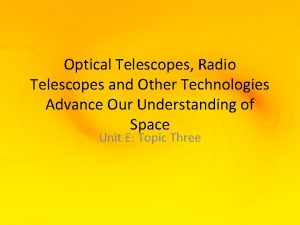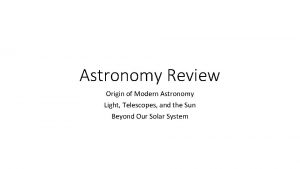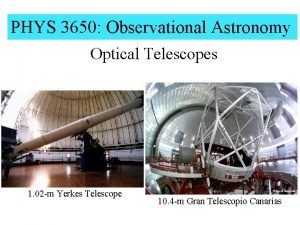The Universe Tools of Astronomy Optical Telescopes Use





















- Slides: 21

The Universe

Tools of Astronomy: Optical Telescopes: Use visible light to examine objects not visible to the naked eye. Types of optical telescopes: 1. Refracting: Uses two glass lenses connected by a tube. 2. Reflecting: uses mirror to gather light and concentrate it at a single location.

Optical Telescopes in Space: On Earth, magnification in very large telescopes is limited because the atmosphere refracts light. To solve this problem, starting in the 1990 s, robot telescopes have been placed in orbit above the atmosphere.

Using Non-Visible Parts of the Electromagnetic Spectrum” Beginning in the early 1900’s, astronomers have used parts of the electromagnetic spectrum not usually detected by human senses, using these tools: 1. Radio telescopes: allows us to detect total energy produced by stars 2. Infrared photography: allows us to see into gas clouds 3. Spectroscopes: allow us to calculate the motion of stars and galaxies, and to determine the composition of stars and planets. 4. X-rays: allows us to detect very powerful events like supernovae and the creation of black holes.

Using spectroscopes and optical telescopes, and a knowledge of the Doppler Effect, in 1922 American astronomer Edwin Hubble was able to discover that the universe, is rapidly expanding.

Homework: LO: Identify and describe tools used by modern astronomers. SLE: Meet or exceed NGSS 1. Read p. 8 -13 2. Respond to review questions on p. 13

Moons of Our Solar System: Natural or man-made objects that orbit around planets are called satellites. If the satellite is large enough to have enough gravity to be spherical, it’s called a moon.

Earth’s Moon: Features of Earth’s moon: Age: about 4. 5 billion years (Earth is 4. 6 billion years old) Composition: rock that is identical to Earth’s rock. Surface: Covered with low mountains, smooth plains and impact craters from meteors. Atmosphere: none Mass: 1/6 of Earth’s mass (16%) Surface temp: -170 to 134 C Period of rotation: 28 days Period of revolution: 28 days

The origin of the moon: The rock found on the moon is chemically identical to the rock on Earth. Scientists currently believe that, early in Earth’s history, a massive asteroid collided with Earth. Some of Earth’s molten material was ejected into orbit around Earth, and when it cooled it became our moon.

Phases of the moon:

Eclipses: Lunar Eclipse: When the earth comes between the sun and the moon and casts its shadow on the surface of the moon. Solar Eclipse: When the moon comes between the earth and sun and casts its shadow on part of the earth.

Moons of other planets: Mars: 2 moons, Phobos and Deimos Jupiter: 67 at last count. The most massive of these, Ganymede, Callisto, Io and Europa, were discovered by Galileo and are called Galilean satellites. Io is very close to Jupiter, and the gravitational tug causes it have almost constant volcanic eruptions.

Saturn: 62 moons at last count. One of them, Titan, is the largest moon in the solar system. Another moon, Enceladus, is covered in frozen water. Methane eruptions from Enceladus is probably the cause of Saturn’s rings.

Homework: LO: Describe moons of our solar system SLE: Meet or exceed NGSS 1. Read p. 110 -116 2. Review questions p. 117

LO: Describe the planets of our solar system. SLE: Meet or exceed NGSS Checkpoint quiz on the solar system: 1. List the planets in order, starting from the sun and going outwards. 2. Which two planets have retrograde rotation around their axes? 3. Describe conditions on the surface of Venus (include composition of the atmosphere). 4. What gas are Jupiter and Saturn mostly made of? 5. Describe the origins of the moon (the one that goes around the earth).

Life Cycle of Large and Small Stars:

Homework: LO: Describe the life cycle of large and small stars SLE: Meet or exceed academic standards 1. Read p. 40 -45 2. Draw a color diagram of the life cycle large and small stars. Include a title (The Life Cycle of Stars), the name of each stage, a picture of the star at each stage, and 1 -2 sentences about what happens to the star at each stage.

Cosmology: looking at the universe all at once Cosmology: the study of the structure, origin, and eventual fate of the universe as a whole. Two major cosmological theories: 1. Steady State Theory: The universe has always existed in more or less its current state, and always will. (most accepted until 1960 s-1970 s)) 2. Big Bang (Inflation) Theory: The universe began as a singularity, and suddenly expanded outwards (currently most accepted theory).

Things to keep in mind about the Big Bang: 1. 2. 3. The Big Bang (inflation) began about 13. 8 billion years ago, and is still occurring. At the level of galaxies and smaller, gravity is a much stronger influence than inflation. The universe is not expanding into a pre-existing space; space itself is expanding. (At the beginning of the big bang, the total volume of the universe was zero. )

Evidence for the Big Bang: 1. Hubble‘s observations of the red shift of distant galaxies can only be explained by an expanding universe. 2. In the 1960 s, two engineers (Arno Penzias and Robert Wilson) accidentally discovered background microwave radiation left over from the big bang: https: //www. youtube. com/watch? v =1 kq. WWLpy. Mp. Y 3. Recent observations of older (more distant) galaxies reveal that they contain far fewer heavy elements than newer (closer) galaxies.

Eventual Fate of the Universe: The eventual fate of the universe depends on the total amount of mass and energy in the cosmos: 1. If the mass is high and energy is low, gravity will eventually cause the exapansion to reverse itself (Big Crunch) 2. If current expansion continues (mass and energy both low), eventually the galaxies will grow too far apart, new stars will no longer form, and eventually the universe will dissolve into a spreadout expanse of black holes and gas remnants (Big Freeze) 3. If expansion accelerates (mass is low and energy high), most of the known universe will suddenly race out ahead of our event horizon (Big Rip). Most recent observations support the Big Rip.
 All modern large optical telescopes are refractors.
All modern large optical telescopes are refractors. Learning astronomy by doing astronomy activity 1 answers
Learning astronomy by doing astronomy activity 1 answers Learning astronomy by doing astronomy activity 1 answers
Learning astronomy by doing astronomy activity 1 answers Learning astronomy by doing astronomy activity 1 answers
Learning astronomy by doing astronomy activity 1 answers A building that contains one or more telescopes
A building that contains one or more telescopes Chromatic aberration affects reflector telescopes
Chromatic aberration affects reflector telescopes Light bucket telescope
Light bucket telescope Computer controlled telescopes
Computer controlled telescopes How do radio telescopes work
How do radio telescopes work Modern telescopes make it possible for astronomers
Modern telescopes make it possible for astronomers Guidepost of light
Guidepost of light New moon telescopes
New moon telescopes Star testing telescope
Star testing telescope Timeline of telescopes
Timeline of telescopes Refracting telescopes exhibit great focus and color
Refracting telescopes exhibit great focus and color How do telescopes work
How do telescopes work Cutting tools in sewing with pictures and meaning
Cutting tools in sewing with pictures and meaning Hình ảnh bộ gõ cơ thể búng tay
Hình ảnh bộ gõ cơ thể búng tay Ng-html
Ng-html Bổ thể
Bổ thể Tỉ lệ cơ thể trẻ em
Tỉ lệ cơ thể trẻ em Chó sói
Chó sói
